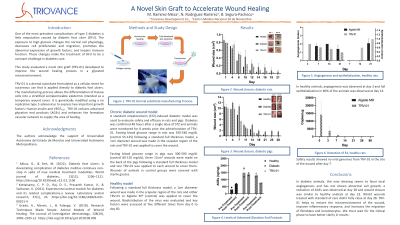Laboratory Research
(LR-018) Genetically modified skin graft to accelerate wound healing

One of the most prevalent complications of type 2 diabetes is limb amputation caused by diabetic foot ulcer (DFU). The exposure to high glucose changes the normal cell physiology, decreases cell proliferation and migration, promotes de abnormal expression of growth factors, and impairs immune function. These changes make the treatment of DFU to be a constant challenge in diabetes care.
This study evaluated a novel skin graft to improve the wound healing in a glycated microenvironment. This skin graft is a full epidermis genetically modified using a no replicative type 5 adenovirus to express two important growth factors: Human insulin and VEGF165. It reduces advanced glycation end products (AGEs) and enhances the formation vascular network to supply the area of healing.
Methods: Using full thickness wound model, the skin graft was apply in two chronic diabetic species to evaluate safety and efficacy at day 28. Biodistribution of the virus was evaluated in healthy rats, key factors were assessed at five different times from day 0 to day 60. Wound size was assessed using a digital wound measurement system, VEGF and C-Peptide in serum were measured using ELISA kits and PCR assays were performed to detect viral genomes. Histological analysis of the wound site was also performed.
Results: In chronic diabetic animals, a reduction of AGEs was observed at day 28 and wound closure was similar to healthy animals at day 23. Whilst wounds treated with standard of care didn't fully close at day 28. Key factors evaluated in healthy animals at different times showed angiogenesis at day 3 and a fully epithelization in 60% of the animals at day 14. Safety results showed no differences in VEGF and C-Peptide in serum concentration and no viral genomes were found after day 7.
Discussion:
In diabetic animals, this new dressing seems to favor local angiogenesis and has not shown abnormal cell growth associated with the creation method. It helps to restore the microenvironment of the wound, improve inflammatory response, and increases the migration of fibroblast and keratinocytes. We must wait for the clinical phase to have better clarity in results.
Trademarked Items:
References:

.png)